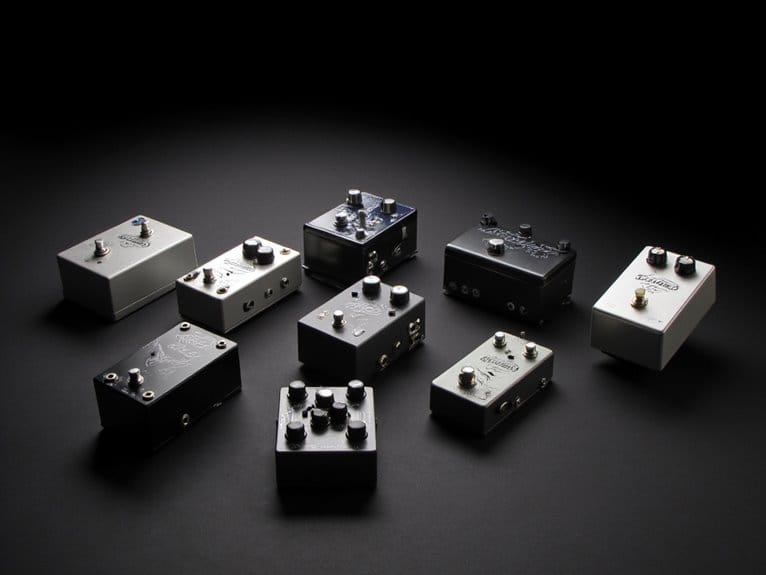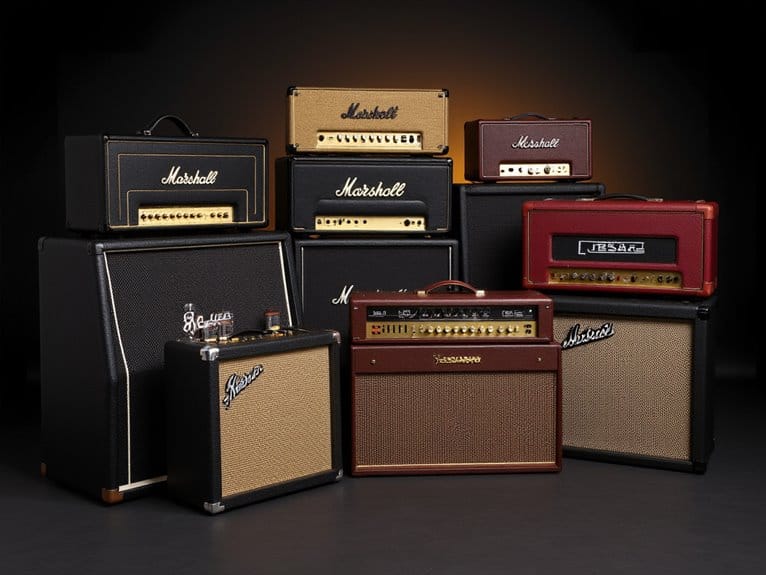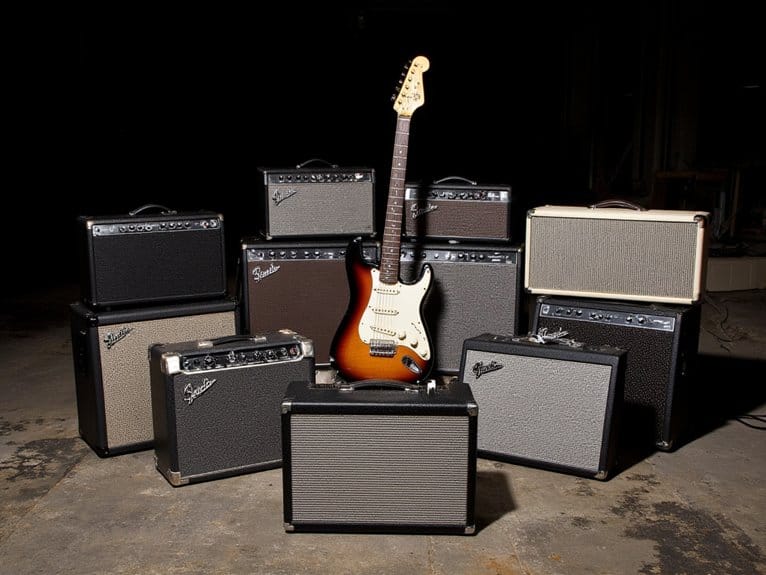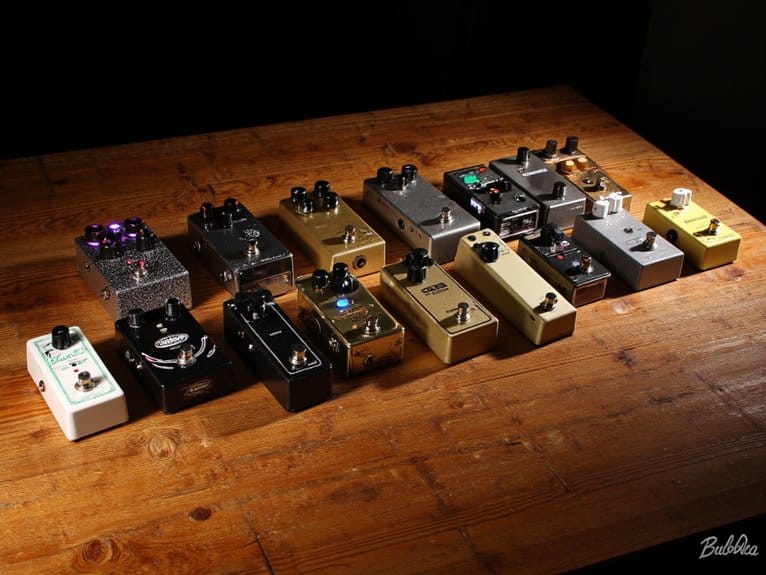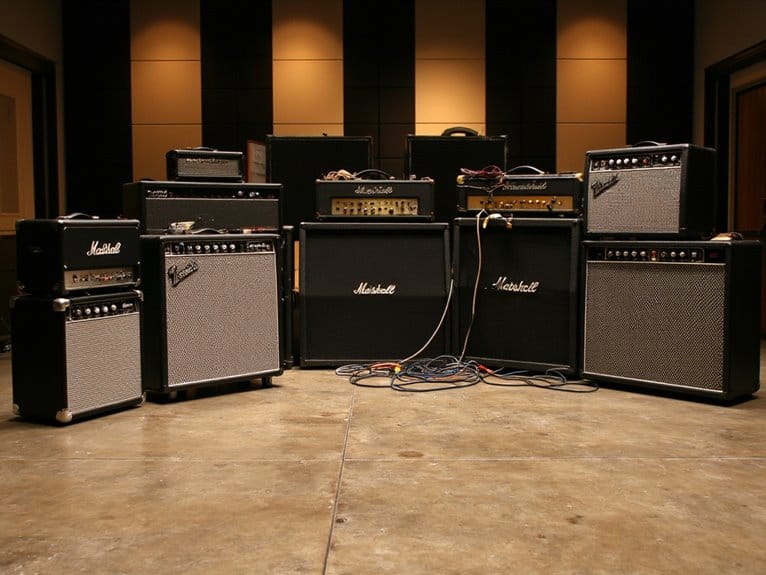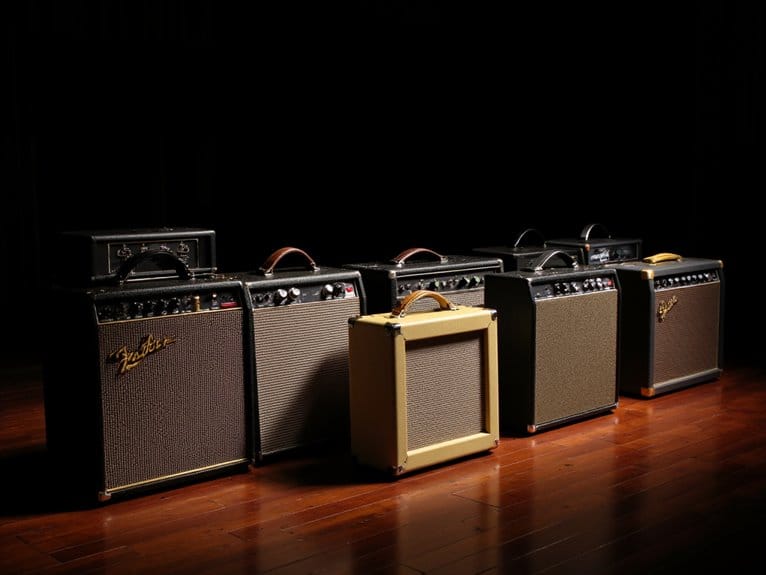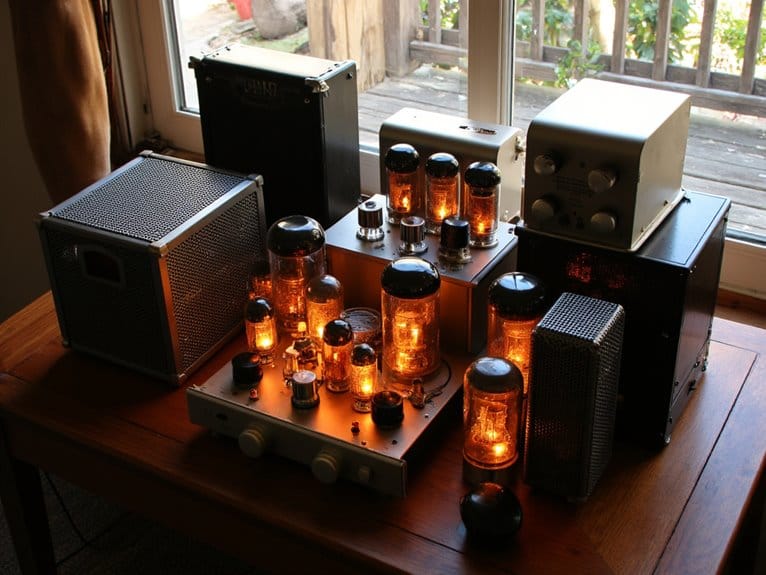10 Best Load Box for Guitar Amp
After testing numerous models in my home studio, I’ve found the Two Notes Torpedo Captor X and Universal Audio Ox Amp Top Box lead the pack for serious recording, offering exceptional speaker simulation and up to 100-watt power handling. For budget-conscious players, I recommend the JOYO Cab-Box R-08, which delivers surprising quality cabinet modeling at a fraction of the cost. The specifications below reveal why these particular models consistently outperform their competition.
We are supported by our audience. When you purchase through links on our site, we may earn an affiliate commission, at no extra cost for you. Learn more.
Notable Insights
- Ensure the load box’s power handling capacity matches or exceeds your amplifier’s maximum output wattage to prevent damage.
- Choose models with proper impedance matching to your speaker cabinet specifications, especially critical for protecting tube amplifiers.
- Look for variable attenuation controls that allow precise volume adjustments for different recording and practice environments.
- Prioritize load boxes with high-quality speaker simulation and impulse response capabilities for authentic recorded tone quality.
- Consider connectivity features like USB outputs, XLR balanced outputs, and app integration for enhanced studio workflow convenience.
Two Notes Torpedo Captor Reactive Loadbox DI and Attenuator – 8 Ohm
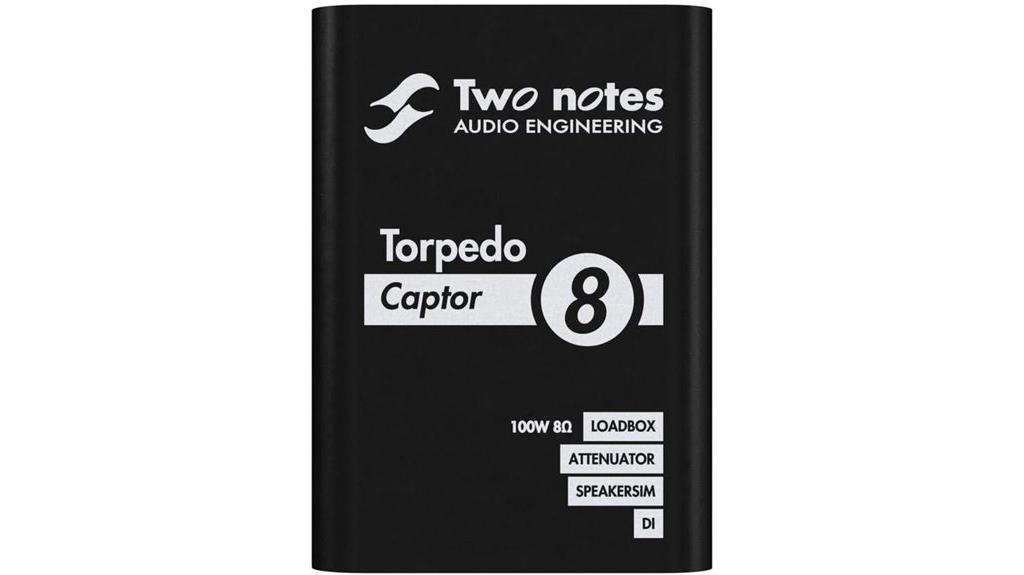
If you’re a guitarist who craves that sweet spot of cranked tube amp saturation without rattling your neighbors’ windows, the Two Notes Torpedo Captor stands as your sonic diplomat. This 8-ohm reactive loadbox delivers a fixed -20dB attenuation, handling amplifiers up to 100 watts while preserving your tube amp’s natural compression and harmonic complexity. You’ll get built-in speaker simulation with 16 DynIR virtual cabinets through the included GENOME plug-in, plus a lifetime license for Torpedo Wall of Sound. At 2.86 pounds, it’s compact enough for any pedalboard, though some users report slight distortion with certain high-output amps like the Fender Hot Rod Deluxe IV.
Best For: Guitarists who want to achieve cranked tube amp tones at lower volumes for home practice, recording, or small venue performances without sacrificing natural tube saturation and harmonic complexity.
Pros:
- Preserves tube amp’s natural compression and harmonic complexity with reactive load technology
- Includes comprehensive recording solution with 16 DynIR virtual cabinets and lifetime Torpedo Wall of Sound license
- Compact and lightweight design (2.86 lbs) that fits easily on pedalboards while handling amps up to 100 watts
Cons:
- Fixed -20dB attenuation only, with no variable attenuation options for different volume needs
- Some users experience slight distortion with certain high-output amplifiers like the Fender Hot Rod Deluxe IV
- Limited to 8-ohm impedance matching, requiring careful attention to amp-speaker compatibility for optimal performance
Universal Audio Ox Amp Top Box

Premium tube amp enthusiasts who crave authentic studio-miked tones without the hassle of conventional recording setups will find their holy grail in Universal Audio’s Ox Amp Top Box, a sophisticated reactive load box that transforms any tube amplifier into a silent recording powerhouse. This 20-pound unit delivers five attenuation levels, from whisper-quiet practice to full band volume, while maintaining your amp’s natural tube saturation and dynamics. The Dynamic Speaker Modeling technology accurately captures speaker breakup, cone cry, and harmonic complexity that typically occurs only at ear-splitting volumes. You’ll access 22 vintage cabinet emulations featuring iconic Celestion, Jensen, and JBL speakers through the intuitive front-panel RIG control, plus Wi-Fi connectivity for detailed tweaking via the OX App.
Best For: Premium tube amp enthusiasts who want authentic studio-miked tones at any volume level without the complexity of traditional recording setups.
Pros:
- Dynamic Speaker Modeling technology accurately captures speaker breakup and harmonic complexity at any volume level
- Five attenuation levels allow silent practice to full band volume while maintaining tube amp dynamics
- Comprehensive recording features with 22 cabinet emulations and Wi-Fi control via OX App for easy preset management
Cons:
- High price point at 20 pounds and premium positioning may not suit budget-conscious musicians
- Some users reported issues with specific settings and delayed Windows support rollouts
- Complex feature set may overwhelm users seeking simple volume attenuation solutions
Two Notes Torpedo Captor X Reactive Loadbox DI and Attenuator – 8-ohm
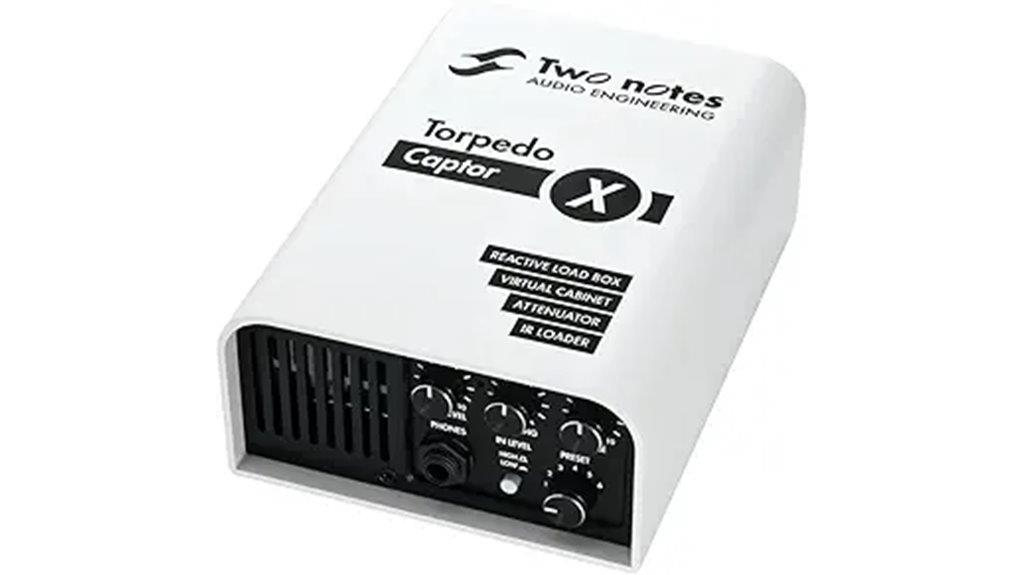
Musicians seeking complete volume control without sacrificing their amp’s natural tone will find the Two Notes Torpedo Captor X Reactive Loadbox DI and Attenuator particularly compelling, as it delivers authentic tube saturation at whisper-quiet levels through its sophisticated 8-ohm reactive loading technology. You’ll appreciate its compact 3.92-pound design that handles 100 watts while providing IR loading, cab simulation, and stereo expansion capabilities. The device’s real-time tone shaping via laptop, mobile app, or MIDI controller offers remarkable flexibility for home practice and stage performance. At 4.6 stars from 73 reviews, it’s earned recognition for delivering Universal Audio Ox-level quality at a considerable lower price point.
Best For: Musicians who want to practice at home with authentic tube amp tone at low volumes, record silently with high-quality cabinet simulations, and need flexible attenuation options for different venue sizes.
Pros:
- Delivers authentic tube saturation and natural amp tone at whisper-quiet levels through sophisticated 8-ohm reactive loading technology
- Compact and lightweight design (3.92 pounds) with versatile functionality including IR loading, cab simulation, stereo expansion, and real-time tone shaping via multiple control options
- Excellent value proposition offering Universal Audio Ox-level quality at a significantly lower price point with strong customer satisfaction (4.6/5 stars)
Cons:
- Some users request more attenuation settings for greater volume control flexibility
- Limited customizable microphone placement options compared to what some customers desire
- Requires additional learning curve to fully utilize all app functionality and tone shaping features
JOYO Cabinet Modeling and Power Amp Simulator Effect Pedal (Cab-Box R-08)
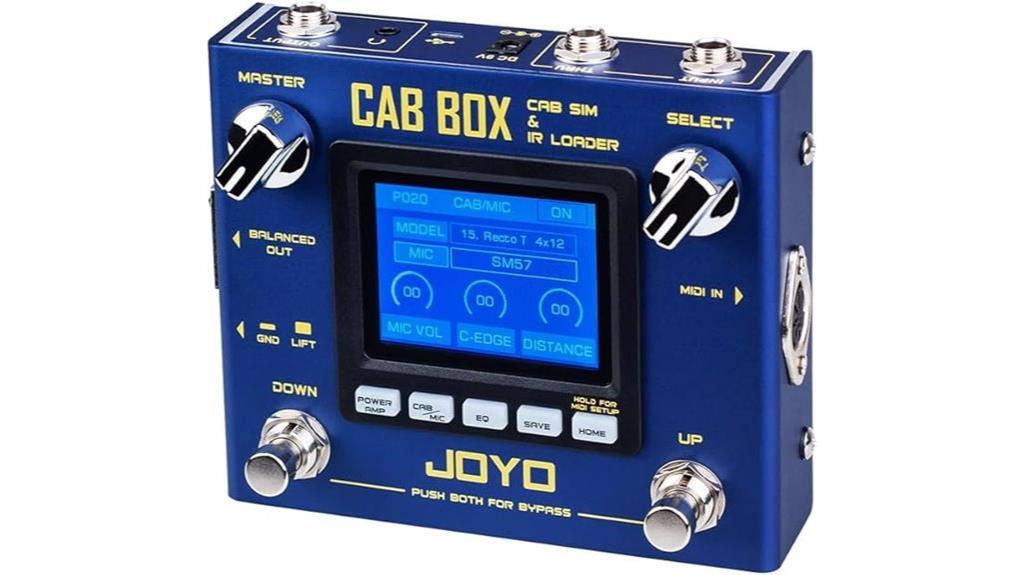
Budget-conscious guitarists who refuse to compromise on professional-grade cabinet simulation will find their perfect match in the JOYO Cabinet Modeling and Power Amp Simulator Effect Pedal (Cab-Box R-08), a feature-packed powerhouse that delivers studio-quality tones without the premium price tag. You’ll discover 20 cabinet models, 11 microphone options, and four tube power amp simulations packed into this surprisingly thorough unit. The larger screen and intuitive button layout make navigation effortless, while 128 tone storage positions guarantee you’ll never run out of space for your carefully crafted sounds. Third-party IR loading capability adds professional flexibility typically reserved for higher-priced competitors.
Best For: Budget-conscious guitarists who want professional-grade cabinet simulation and power amp modeling with extensive customization options for both stage and studio use.
Pros:
- Exceptional value with 20 cabinet models, 11 microphone options, and third-party IR loading capability at an affordable price point
- Large screen with intuitive controls and massive 128 tone storage positions for extensive sound library management
- Versatile connectivity including USB compatibility, MIDI control, and stereo FX loop connection for professional integration
Cons:
- No battery compartment limits portability and requires constant power source connection
- Requires JOYO original adapter for optimal performance to avoid unwanted noise issues
- Build materials include mixed components (aluminum, steel, carbon fiber) which may affect long-term durability compared to premium all-metal construction
Suhr 07-RCL-0002 Reactive Load IR Box
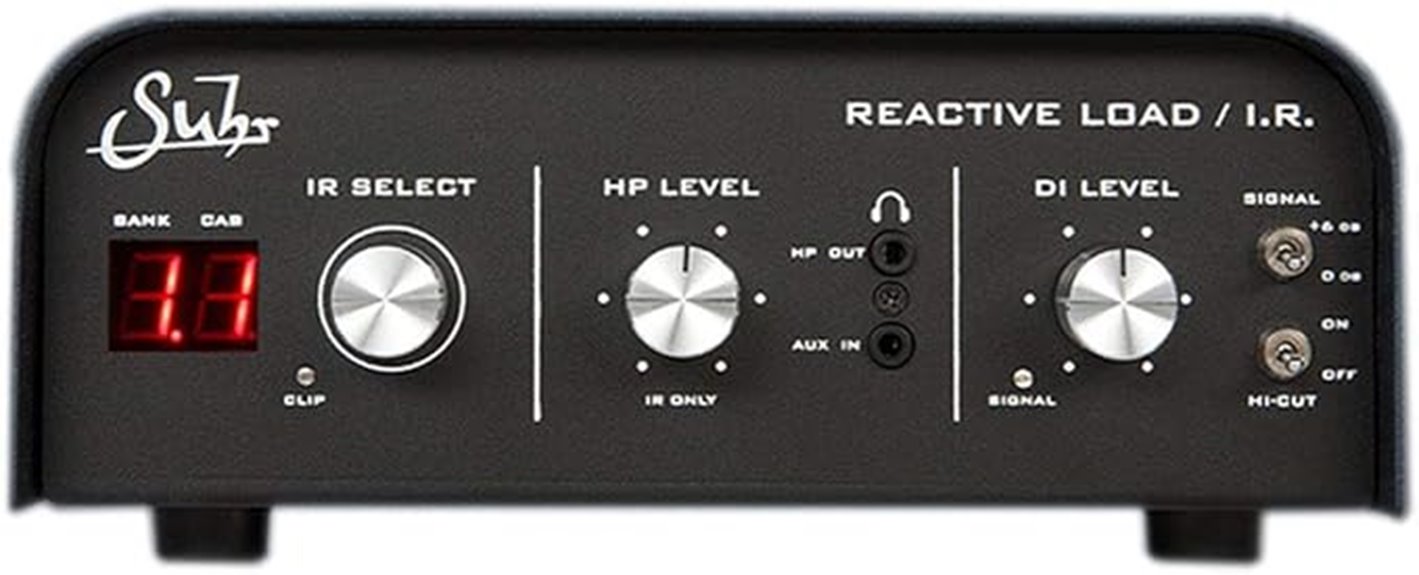
When you’re seeking a thorough solution that eliminates the need for separate DAW software or complex plugin chains, the Suhr 07-RCL-0002 Reactive Load IR Box delivers an all-in-one package that’s particularly valuable for guitarists who want authentic tube amp tones at conversation-friendly volumes. You’ll find sixteen preloaded Suhr cabinet impulse responses captured by Celestion, plus the flexibility to load third-party IRs via USB. The aux input lets you jam along with backing tracks from your phone, while the reactive load guarantees your amp’s output tubes maintain their natural compression characteristics. At 4.7 stars from twenty-two reviews, users consistently praise its recording quality and straightforward operation.
Best For: Guitarists who want to practice and record with tube amps at low volumes while maintaining authentic tone through high-quality impulse responses.
Pros:
- All-in-one solution with 16 preloaded Suhr cabinet IRs and ability to load third-party impulse responses via USB
- Reactive load preserves natural tube amp compression and dynamics at any volume level
- Aux input allows playing along with backing tracks from external devices like smartphones
Cons:
- Limited to 7 watts of power handling which may not accommodate higher wattage amplifiers
- Relatively niche product with only 22 customer reviews indicating smaller user base
- Requires understanding of impulse response technology to fully utilize all features
JOYO Passive Reamping and Phantom Powered Active Direct Box (JDI-48)
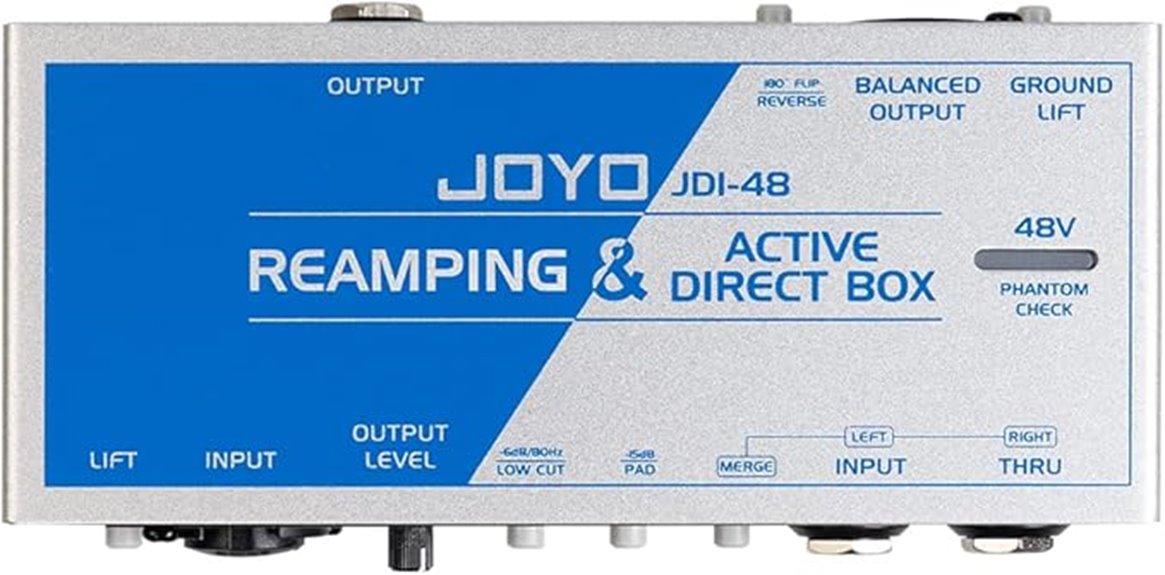
If you’re juggling both studio recording and live performance needs, the JOYO JDI-48 delivers dual functionality that eliminates the hassle of carrying separate units for direct injection and reamping tasks. This aluminum-bodied device operates on 48V phantom power, which means you won’t deal with dead batteries during vital sessions. The unit includes practical features like a low-cut filter, -15dB attenuation, phase reverse, and ground lift switch that actually works for noise reduction. Users consistently praise its signal clarity and build quality, rating it 4.7 out of 5 stars. At around $99, it competes effectively with pricier alternatives.
Best For: Musicians and recording engineers who need a versatile, reliable unit that handles both direct injection and reamping functions for studio recording and live performance without requiring batteries.
Pros:
- Combines DI and reamping functions in one compact, well-built aluminum unit
- Operates on 48V phantom power, eliminating battery dependency and potential power failures
- Includes essential features like low-cut filter, ground lift, phase reverse, and -15dB attenuation for professional signal management
Cons:
- Requires phantom power source, making it dependent on compatible equipment rather than being standalone
- Lacks onboard level meters, requiring some trial-and-error during initial setup
- Limited to analog signal processing without digital connectivity options
Leo Jaymz Guitar/Bass Effects Pedal Amplifier with 32 Presets

The Leo Jaymz Guitar/Bass Effects Pedal Amplifier stands out as the ideal choice for recording musicians and practice enthusiasts who demand professional cabinet simulation without the volume constraints of traditional amplification. You’ll get 32 presets featuring 25 electric guitar and seven bass cabinet simulations, delivering studio-quality sound through its impressive 103dB SNR and 44.1kHz/24-bit sampling rate specifications. The professional nine-band EQ covers 20Hz to 18kHz with ±12dB range, allowing precise tonal sculpting that rivals expensive studio processors. With low latency under 1.5ms, you won’t experience the frustrating delays that plague lesser units, while USB connectivity enables seamless preset management through PC software or mobile apps.
Best For: Recording musicians and practice enthusiasts who need professional cabinet simulation for home studios or quiet practice sessions without the volume and space requirements of traditional amplifiers.
Pros:
- High-quality audio specs with 103dB SNR and 44.1kHz/24-bit sampling rate deliver studio-grade sound
- Extensive customization options with 32 built-in presets, third-party IR file support, and professional 9-band EQ
- Ultra-low latency under 1.5ms ensures responsive playing experience with USB connectivity for easy management
Cons:
- Limited to 32 presets which may not be sufficient for musicians requiring extensive tonal variety
- Requires additional software or mobile app for full customization and IR file loading
- No mention of direct recording capabilities or audio interface functionality for complete studio integration
Factors to Consider When Choosing a Load Box for Guitar Amp
When I’m helping guitarists choose the right load box, I focus on five critical factors that’ll determine whether you get professional results or end up with an expensive paperweight. The power handling capacity must match or exceed your amp’s output, impedance requirements need precise alignment with your speaker cabinet’s specs, and attenuation options should provide the flexibility you need for various recording scenarios. I’ve learned that speaker simulation quality and recording output features often make the difference between a load box that sounds natural versus one that leaves your tone feeling sterile and lifeless.
Power Handling Capacity
Understanding power handling capacity becomes absolutely critical when selecting a load box, as I’ve learned through years of testing various models with amplifiers ranging from 15-watt practice amps to 100-watt tube monsters. I always recommend choosing a load box with power handling that exceeds your amplifier’s maximum output, which prevents damage during those inevitable late-night recording sessions when I push everything to eleven. Matching impedance ratings between your amp and load box remains equally important, whether you’re dealing with 4-ohm or 8-ohm configurations. Most quality load boxes offer fixed attenuation settings like -20 dB, allowing you to achieve those coveted cranked-amp tones at apartment-friendly volumes while maintaining tonal integrity that’ll keep your neighbors happy.
Impedance Matching Requirements
Although power handling gets most of the attention when shopping for load boxes, I’ve discovered that impedance matching actually determines whether your expensive tube amp survives those marathon recording sessions or becomes an expensive paperweight. Most tube amps operate between 4 to 16 ohms, and I always match my load box’s impedance exactly to my amp’s output rating for ideal performance. While using a higher impedance load box won’t damage your amp, it’ll reduce power transfer and potentially alter your tone in ways you didn’t plan for. Mismatched impedance can cause tonal degradation, reduced output power, and long-term amplifier damage that’ll make your wallet weep. I prefer load boxes with selectable impedance options since they offer flexibility across different amplifier setups.
Attenuation Level Options
After spending countless hours tweaking amp settings in both cramped home studios and spacious venues, I’ve learned that attenuation level options make the difference between a load box that serves your needs and one that collects dust in your gear closet. Fixed settings like -20dB offer straightforward operation, perfect when you don’t want to overthink volume reduction. However, I prefer variable attenuation controls that let me dial in precise levels for different situations, whether I’m recording late-night ideas or performing at modest club volumes. The best load boxes feature multiple toggleable options, allowing real-time adjustments during performances. Choosing appropriate attenuation levels guarantees you’ll maintain your amp’s sonic character while achieving practical volume management.
Speaker Simulation Quality
Three critical elements determine whether your load box’s speaker simulation will sound convincing or like a cheap amp modeler from 2003: impulse response quality, microphone modeling variety, and dynamic speaker behavior reproduction. I’ve found that convincing speaker simulation requires high-quality IRs that capture renowned cabinet characteristics, multiple microphone placement options for tonal versatility, and dynamic modeling that emulates real speaker drive and breakup. The best units come preloaded with professional-grade impulse responses while allowing third-party IR loading for expanded sonic possibilities. Advanced load boxes incorporate dynamic speaker modeling, preserving tube amp dynamics even at bedroom volumes. This thorough approach guarantees your recordings maintain the authentic tonal richness and authenticity of actual speaker cabinets.
Recording Output Features
Once you’ve nailed down speaker simulation quality, the recording output features become your gateway to seamless studio integration, and I’ve learned that the wrong connectivity choices can turn a promising session into a frustrating cable hunt. I prioritize load boxes with USB outputs since they eliminate the need for additional interfaces, though traditional line outputs offer more flexibility with existing setups. The attenuation controls are essential – I can dial in those sweet tube saturation tones at apartment-friendly volumes, which my neighbors definitely appreciate. Quality IR technology makes a massive difference in your recorded sound, with premium models offering extensive virtual cabinet libraries. Silent recording capabilities mean I can capture ideas at 2 AM without disturbing anyone, turning creative inspiration into actual tracks.
Build Quality Durability
When I’m examining a load box that’ll potentially handle hundreds of hours under stage lights and countless studio sessions, the build quality becomes the foundation that determines whether you’re making an investment or buying an expensive paperweight. I always prioritize all-metal or reinforced steel chassis construction, since flimsy plastic housings won’t survive the rigors of gigging life. While I appreciate lightweight designs for transport convenience, I’ve learned that truly portable units must balance weight reduction with structural integrity. High-grade connectors and cables prevent those frustrating mid-session failures that can derail recording momentum. I pay close attention to compact layouts and thoughtful design features that enhance integration ease. User reviews consistently reveal long-term durability patterns, helping me distinguish between genuinely robust units and cleverly marketed disappointments.
Price Value Ratio
The calculator doesn’t lie when I’m staring at load box price tags that range from under $100 to well over $1,000, making the value equation far more complex than simply choosing the cheapest option that meets basic requirements. I’ve learned that core features like attenuation options and cabinet simulations directly impact my investment’s worthiness, while premium models with dynamic speaker modeling and extensive impulse response libraries justify higher costs through enhanced recording flexibility. Budget options often sacrifice build quality or features, which affects long-term performance and durability. I always check customer ratings for reliability insights and examine warranty terms, since responsive support and extended coverage can make that higher price tag worthwhile for serious recording applications.
On a final note
I’ve tested countless load boxes over the years, and honestly, each serves different needs depending on your setup, budget, and recording requirements. Whether you’re chasing that cranked tube tone at bedroom volumes with the Universal Audio Ox, or need simple attenuation with the Two Notes Captor, there’s something here for every guitarist. Consider your specific use case, available connections, and desired features before making your final decision.

